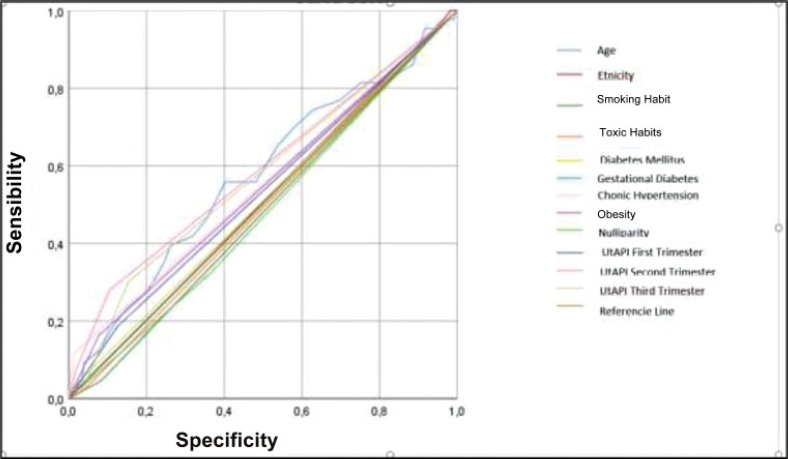-
Original Article
Uterine Artery Pulsatility Index as a Pre-eclampsia Predictor in the 3 Trimesters in Women with Singleton Pregnancies
Revista Brasileira de Ginecologia e Obstetrícia. 2021;43(12):904-910
01-24-2021
Summary
Original ArticleUterine Artery Pulsatility Index as a Pre-eclampsia Predictor in the 3 Trimesters in Women with Singleton Pregnancies
Revista Brasileira de Ginecologia e Obstetrícia. 2021;43(12):904-910
01-24-2021Views177See moreAbstract
Objective
To evaluate the mean uterine artery pulsatility index (UtAPI) in each trimester of pregnancy as a predictor of early or late pre-eclampsia (PE) in Colombian pregnant women.
Methods
The UtAPI was measured in singleton pregnancies in each trimester. Uterine artery pulsatility index as predictor of PE was evaluated by odds ratio (OR), receiver operating characteristic (ROC) curves, and Kaplan-Meier diagram.
Results
Analysis in the 1st and 3rd trimester showed that abnormal UtAPI was associated with early PE (OR: 5.99: 95% confidence interval [CI]: 1.64–21.13; and OR: 10.32; 95%CI: 2.75–42.49, respectively). Sensitivity and specificity were 71.4 and 79.6%, respectively, for developing PE (area under the curve [AUC]: 0.922). The Kaplan-Meier curve showed that a UtAPI of 0.76 (95%CI: 0.58–1.0) in the 1st trimester was associated with early PE, and a UtAPI of 0.73 (95%CI: 0.55–0.97) in the 3rd trimester was associated with late PE.
Conclusion
Uterine arteries proved to be a useful predictor tool in the 1st and 3rd trimesters for early PE and in the 3rd trimester for late PE in a pregnant population with high prevalence of PE.

-
Original Article
The Relationship between Serum Ischemia-Modified Albumin Levels and Uterine Artery Doppler Parameters in Patients with Primary Dysmenorrhea
Revista Brasileira de Ginecologia e Obstetrícia. 2020;42(10):630-633
12-21-2020
Summary
Original ArticleThe Relationship between Serum Ischemia-Modified Albumin Levels and Uterine Artery Doppler Parameters in Patients with Primary Dysmenorrhea
Revista Brasileira de Ginecologia e Obstetrícia. 2020;42(10):630-633
12-21-2020Views190See moreAbstract
Objective
Primary dysmenorrhea occurs due to abnormal levels of prostanoids, uterine contractions, and uterine blood flow. However, the reasons for pain in primary dysmenorrhea have not yet been clarified. We examined the blood flow alterations in patients with primary dysmenorrhea and determined the relationship between ischemia-modified albumin (IMA) levels, as an ischemia indicator, and primary dysmenorrhea.
Methods
In the present study, 37 patients who had primary dysmenorrhea and were in their luteal and menstrual phase of their menstrual cycles were included. Thirty individuals who had similar demographic characteristics, who were between 18 and 30 years old and did not have gynecologic disease were included as control individuals. Their uterine artery Doppler indices and serum IMA levels were measured.
Results
Menstrual phase plasma IMA levels were significantly higher than luteal phase IMA levels, both in the patient and in the control groups (p < 0.001). Although the menstrual phase IMA levels of patients were significantly higher than those of controls, luteal phase IMA levels were not significantly different between the two groups. Menstrual uterine artery pulsatility index (PI) and resistance index (RI) of primary dysmenorrhea patients were significantly different when compared with luteal uterine artery PI and RI levels. There was a positive correlation between menstrual phase IMA and uterine artery PI and RI in the primary dysmenorrhea.
Conclusion
Ischemia plays an important role in the etiology of the pain, which is frequently observed in patients with primary dysmenorrhea. Ischemia-modified albumin levels are considered as an efficient marker to determine the severity of pain and to indicate ischemia in primary dysmenorrhea.


